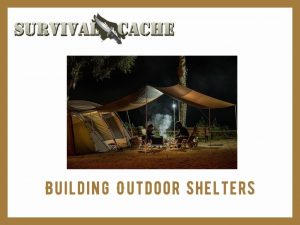According to the rules of three, exposure to the elements can kill faster than anything else, other than lack of oxygen of course. This means that maintaining core body temperature, specifically by building a shelter, is rather important.

There are a whole bunch of different ways to make a survival shelter. A-frame, lean-to, teepee, just to name a few. When you take into account the different materials that can be used as well you will start to see that there are various building options.
I should start by saying that if you are looking for an article on detailed shelter construction, this probably isn’t the article for you.
Instead, in this article I intend on discussing topics associated with shelters rather than the actual construction of them. I wanted to be in with answering a question that inevitably pops up in these types of topics.
SKIP AHEAD
The Best Shelter For Survival

Over the years I have seen and heard this question a lot, “What is the best shelter to build?” I do have an answer to this question, but it is in the form of another question in order to get people thinking. And that question is “What is the primary function of a shelter?”
In my opinion, the primary purpose of a shelter is to protect from the elements with the secondary purpose being protection from wildlife.
With that in mind here is my answer to the original question. The best shelter is the one that you know how to build at that time, with what is available, and that will offer protection from the environment you are in. Is that as clear as mud? Okay, here is an extreme example to better illustrate what I am talking about.
I hear people talk about lean-tos a lot so let’s use that for this example. This may be a perfectly acceptable shelter to build in an environment with decent weather and minimal predators or critters to be concerned with. It is quick and easy to build and will provide a bit of shade in hot conditions.
But in a cold, windy environment a lean-to is probably not going to be the best option because it is does not retain heat well. Maybe I am wrong but for me, there is not just one best shelter, there are many. It all depends on the environment you are in.
It is best to be skilled in the construction of many different types of shelters as well as using different types of materials. This way you can be as prepared as possible for applying the right type of shelter to the conditions you are in.
Make sure to read our guide on bug out bag shelters you can create quickly.
Before Building
While knowing how to build certain types of shelters is important, there a few things that you should keep in mind before ever building an outdoor shelter that is just as important.
Give Yourself Enough Time

Because you want to get out of a survival situation, it can be easy to succumb to the desire of wanting to power through the day. But when you are traveling, it is important to stop early enough in the day to give yourself enough time to find an appropriate campsite and for building a shelter. Depending on the environment and your abilities you may want to give yourself several hours for this task.
Picking a Location
Choosing a campsite is not as easy as simply throwing your bag down in a spot and calling it home for the night. It is important to survey the area for hazards. Such as:
- Avoid widow makers. This includes sleeping under dead trees, broken limbs hanging down, areas with falling rocks, or anything that could fall on you in the night.
- Avoid avalanche zones.
- Avoid flash flood zones. Areas that have water lines above the water source or are particularly littered with debris are an indication of areas that can flood. In dry regions avoid sleeping in low areas or dried out river beds.
- Avoid sleeping too close to a water source. This is especially true of running water sources because their levels can fluctuate quickly. Temperatures will also be much cooler around large water sources like lakes.
- Avoid sleeping too close to game trails or an area heavy with signs of predators.
- Avoid areas with insect nests. There is nothing worse than laying down for the night next to a tree only to find out there is a huge anthill just on the other side.
- Avoid anything else that you deem as a hazard or a potential hazard.
Building a Survival Shelter

Even though a shelter needs to be able to provide protection, keep in mind that conserving energy is key in a survival situation.
The size and durability of the shelter depends on your abilities, the materials available, how much time you have to build, and how long you intend on staying in one location.
To help conserve energy, utilize the landscape as part of the shelter. A large rock or downed tree can provide part of a shelter as well as be used as a piece of the frame.
Use materials that are easy to gather. Unless you are staying in an area for a long time or there are extreme dangers present, chopping down a large tree is usually unnecessary. Gather low hanging branches, wood that is on the ground, grasses, or materials that you have such as a tarp.
When sheltering for the night one of the most important things to remember is insulation. Insulation, insulation, insulation! Always avoid sleeping directly on the ground as a lot of body heat can be lost. Placing an insulating layer of grasses or soft pine boughs on the ground will help to keep you drier and warmer.
Around the Shelter
When it comes to the outside of the shelter here are a few things to consider.
Keep the rising Sun in mind. If possible, point the opening of a shelter in the direction of the Sun. This will help to warm the shelter throughout the day.
Pay attention to wind direction and orientate the shelter so that solid walls are blocking it.
Use a trench to help keep the inside of the shelter dry. Dig a small trench around the perimeter of your shelter. This will help guide rainwater away from the sleeping area instead of the water pooling up around it.
Wrapping It Up
Knowing how to build different types of shelters out of various materials is an important skill to know. But it is equally important to keep in mind the topics discussed in this article to have the safest most comfortable experience. Thanks for reading and stay prepared!

